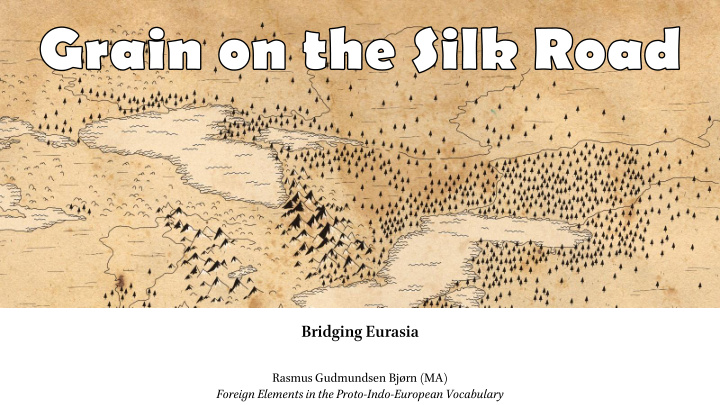



Bridging Eurasia Rasmus Gudmundsen Bjørn (MA) Foreign Elements in the Proto-Indo-European Vocabulary
Eurasia connected The opening of the Steppe - The rise of agriculture, east and west - The Indo-European expansion (West) - Transeurasian expansion (East) - A bridge of languages Rasmus G. Bjørn (MA) Foreign Elements in the Proto-Indo-European Vocabulary
Bridging a continent • There is more than 4000 km from their posited homelands. • Within 2000 years they had split the steppe Rasmus G. Bjørn (MA) Foreign Elements in the Proto-Indo-European Vocabulary
The Steppe – from wasteland to highway • The linguistic void – and how horses changed that • Inhospitable to permanent settlement, requires movement • The Botai culture, Kazakhstan, early horsebreeders (Anthony 2007) • Unknown substrate common to Tocharian and Indo-Iranian (Carling 2005) • Indo-Europeans east of the Urals • First traversed by the Tocharians (ca. 3000 BC) • Conquered by Indo-Iranians (ca. 2100 BC) • Turks and Mongols West of the Altai Rasmus G. Bjørn (MA) Foreign Elements in the Proto-Indo-European Vocabulary
Becoming Transeurasian • Transeurasian ousted Iranian from the Steppe • Connected to Neolithic Boisman culture in the Southern Primorye (4825‒2470 BC) • Mongolic and Turkic receive western admixture with the Bronze age (cf. Robbeets et al. forthc.) • The dispersal of Boisman coincides with the Indo-European eastern traversing of the Steppe, essentially founding the northern Silk Road. Rasmus G. Bjørn (MA) Foreign Elements in the Proto-Indo-European Vocabulary
New methods, new knowledge • Comparative linguistics • Relative chronologies • Potential to preserve cultural aspects • Lot of data, but very few fixed points • Archaeobotanic and isotope analyses • Spread of plants • Change in sustenance strategies • Can date and locate fixed points Rasmus G. Bjørn (MA) Foreign Elements in the Miller et al. 2016 Proto-Indo-European Vocabulary
Agriculture as a vocabulary event • A demonstrable revolution human prehistory • Different crops in different places • Comes with rich terminologies • Many different strains (e.g. types of grain, regional innovations) Rasmus G. Bjørn (MA) Foreign Elements in the Proto-Indo-European Vocabulary
Methodology 1. Build a database of linguistic data • Semantic spheres: agriculture, horticulture • Languages: • Indo-European, primarily the eastern branches, i.e. Indo-Iranian & Tocharian • Transeurasian • Sino-Tibetan 2. Add archaeobotanical and isotope data • Dating, location, strain 3. Describe the spread and posit hypotheses Rasmus G. Bjørn (MA) Foreign Elements in the Proto-Indo-European Vocabulary
Different crops, different data • Innovations spread at different rates • On the following slides we will look at two early crops Rasmus G. Bjørn (MA) Foreign Elements in the Proto-Indo-European Vocabulary
Case 1: ‘ Barley ’ • Different types • Early western Eurasian crop (Badr et al. 2000) Indo-European Turkic Tungusic Sino-Tibetan W-PIE * b h ar- P-Iran. * arbusa- >> PTurk. * arba P-Iran. * karšaka >> OChin. * klas ‘ grain, sow ’ *murgi Mallory & Adams (1997) & Robbeets et al. (forthc.) Rasmus G. Bjørn (MA) Foreign Elements in the Proto-Indo-European Vocabulary
Case 2: Millet • First domesticated in NE China 6 th mil. BC (Miller et al. 2016) • Central crop for the Transeurasian family • Different species, broomcorn (BC), barnyard (BY), and foxtail (F) Indo-European Turkic Mongolic Tungusic Koreanic Japonic * konak (F) <- * ko- ‘to put’ >> * konag (F) * ügür (BC) * amun (BC) * pisi-ke (BC) ~ * pihi (BY) * jiya- (F) * ip-i <- *pi- ‘ to eat ’ P-Iran. * pan- Rasmus G. Bjørn (MA) Foreign Elements in the Mallory & Adams (1997) & Robbeets et al. (forthc.) Proto-Indo-European Vocabulary
Exchanging barley and millet • Internal transfers of millet between dispersing Transeurasian phylae. • Millet late in Indo-European, but not from Transeurasian languages. • Barley, on the other hand, shows clear influences west to east. Rasmus G. Bjørn (MA) Foreign Elements in the Proto-Indo-European Vocabulary
Resources • Indo-European: • DIEAT (Guus Kroonen, CPH & Leiden) • Encyclopedia of Indo-European Culture (Mallory & Adams) • Transeurasian: • Robbeets et al. (forthc.) • Tenishev (2001) Rasmus G. Bjørn (MA) Foreign Elements in the Proto-Indo-European Vocabulary
Thank you for your attention ! www.loanwords.prehistoricmap.com Bibliography Anthony (2007) The Horse, the Wheel and Language. Princeton. Bjørn (2017) Foreign elements in the PIE vocabulary [ MA thesis/prize paper ]. Copenhagen Badr et al. (2000) ” On the Origin and Domestication History of Barley (Hordeum vulgare) ”. Molecular Biology and Evolution 17(4). Carling (2005) ” Proto- Tocharian, Common Tocharian, and Tocharian”. 16 th UCLA IE Conf. , 47-70. Mallory & Adams (1997) Encyclopedia of Indo-European Culture. Chicago & London. Miller et al. (2016) “Millet Cultivation across Eurasia”. The Holocene 26: 1566-1575. Robbeets et al. (forthc.) Oxford Guide to the Traneurasian Languages. Oxford. Tenishev (2001) Sravnitelno-istoricheskaya Grammatika Turskix Yazykov, Leksika. Moscow. Rasmus G. Bjørn (MA) Foreign Elements in the Proto-Indo-European Vocabulary
Recommend
More recommend